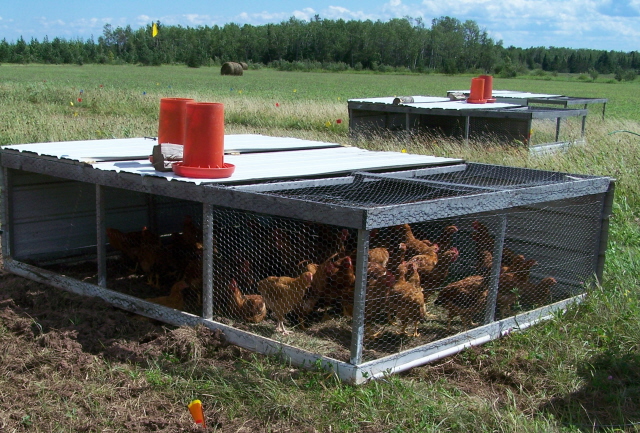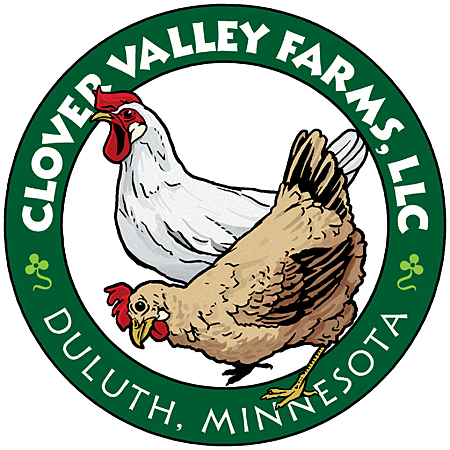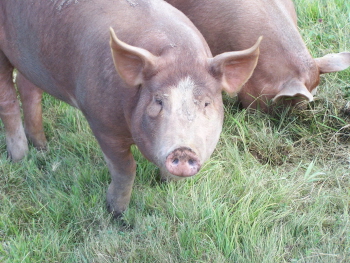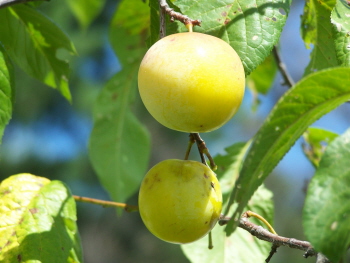Poultry Production
Pastured Poultry Husbandry
Ducklings spend 2 weeks in the brooder, while broiler chicks stay for 3 weeks and turkey poults for 3-4 weeks. Ducklings grow to processing weight (about 7 weeks) in a 165’-perimeter paddock with shade. Broiler chicks and turkey poults grow in 8’ x 10’ Salatin-style pens that are moved daily. Pens contain 5-gallon galvanized water founts that are filled twice daily (morning and evening), and feed is provided using two 22-lb capacity hoppers per pen (see also Feed, and On-Farm Research).
Starting in 2011, ducklings and turkey poults also spent time in the new fenced orchard. Jeff and Cindy put the turkeys in the orchard for the last 5 weeks before processing, after the ducks were processed. The turkeys kept down the weeds and pests better than the ducks, which tended to cluster in one area of the orchard.

Educator’s Perspective: Resource Tip Farmer Joel Salatin of Polyface Farms popularized the “daily move pen” in his book, Pastured Poultry Profits. ATTRA discussed these pens in an article called Range Poultry Housing. Cindy and Jeff have made two modifications to the original design – increasing the height from 2’ to 2.5’ to accommodate turkeys, and adding PVC pipe to the bottom to facilitate sliding the pens across the pasture. With the PVC pipe in place, Cindy and Jeff don’t need to use a dolly on the back of the pen to move it, as described in most applications of Salatin’s pens. |
In 2010, Cornish Broilers were processed at 8 weeks, Red Broilers at 14 weeks, and turkeys at 14 weeks (see Production > Harvest & Processing > Poultry for “lessons learned” on timing of processing).
Spotlight on: Pastured Poultry Husbandry Jeff and Cindy spend about $150 to construct each Salatin-style pen. They are “sold” on this design. They know colleagues that are turned off by the idea of moving the pens every day, but Jeff and Cindy find that it takes only a few extra minutes in addition to feeding and watering the birds. They purposely use construction materials that make the pens light enough for either of them to move by hand. They’ve found that after just a few times the birds get used to the idea of the pen shifting, and they move ahead in anticipation of new forage each day (even the Cornish Broilers, which don’t usually move much at all!). Cindy and Jeff have found that the Salatin-style pens are effective at preventing predation and distributing the manure well with daily moves. The manure breaks down in about two weeks, and the grass that comes up afterward is bright and luscious. They know others swear by “day-range” systems (which consist of a paddock and a coop in which the birds get closed up for the night), but they feel this wouldn’t work well for Cornish Broilers, which tend to be sedentary and unmotivated to forage on pasture. Some people take a combined approach, where they move the day-range system every few weeks after a certain percentage of the vegetation is covered in manure. Cindy and Jeff use each 10’ x 10’ patch of pasture (i.e., the area covered by a Salatin pen) for only one day per year. They have enough pasture so that they don’t have to run chickens behind chickens, and they prefer that because it allows them to maximize pasture regrowth and minimize any potential parasite problems. Jeff and Cindy could keep their ducks in Salatin-style pens as they do with chickens and turkeys, but so far have used a paddock system. One of the key differences between chickens or turkeys and ducks is the amount of water the ducks go through. Although the ducks don’t consume all the water, their tendency to splash around in it requires frequent changes. Jeff and Cindy provide about 15 gallons in the morning and 15 in the evening and say the ducks would happily take more! See "Livestock Water Requirements" for more information about water needs of poultry as well as other livestock. |
Farmer’s Perspective: On The Bookshelf By Jody Padgham This book is a compilation of articles published by the American Pastured Poultry Producers Association. It has fourteen comprehensive chapters and covers a wide range of viewpoints and techniques. In general, Cindy and Jeff have found the APPPA to be a useful source for technical information. The organization publishes a simple monthly newsletter called “Grit!” Cindy and Jeff always seem to learn something new from it. Poultry Your Way: A Guide to Management Alternatives for the Upper Midwest This publication was a joint effort between the Minnesota Institute for Sustainable Agriculture and the Minnesota Department of Agriculture, with funding from North Central Region Sustainable Agriculture Research and Education (NCR-SARE). Free digital and print copies are available. It includes chapters on management, processing, marketing, and planning. |
 |
 |


